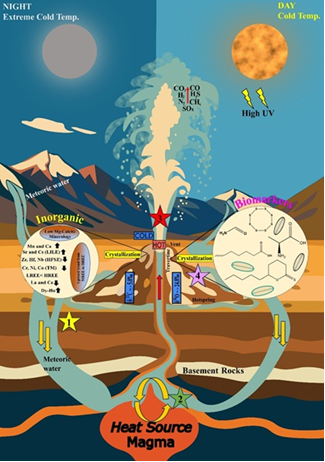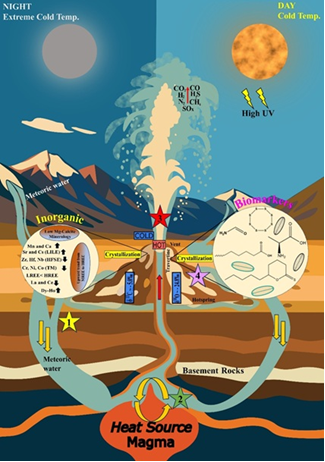In the icy high-altitude valleys of Ladakh, India, a natural hot spring in Puga valley may be holding secrets from the very dawn of life on Earth.
A team of Indian scientists has made a breakthrough discovery that could not only rewrite our understanding of how life may have originated on Earth and shedding light on how astrobiological process related to finding biosignatures of life on other planetary bodies like MARS may have occurred.
Till date Silica based origin of life theories are proposed globally and role of carbonates specifically Ca has been unexplored. Prior studies showed calcite can catalyse prebiotic reactions in laboratory settings.
Scientists from Birbal Sahni Institute of Palaeosciences (BSIP) an autonomous institute of the Department of Science and Technology (DST) observed rapid carbonate precipitation in the environment of Puga valley, a high-altitude valley in Ladakh, India, known for its geothermal activity and hot springs. This Project was executed under newly formed Earth and Planetary Exploration Group (EPEG) at BSIP.

Fig 1. Conceptual model of travertine formation and geochemical record at the Puga hot spring, Ladakh.
Dr. Amritpal Singh Chaddha, Dr. Sunil Kumar Shukla, Dr. Anupam Sharma, Prof. M.G. Thakkar, Dr. Kamlesh Kumar hypothesised that the extreme environment of Puga could act as a real-world prebiotic reactor and preservation site and provide real world evidence of the phenomenon.
In an interdisciplinary study, the team analysed the high-altitude hot spring travertine (calcium carbonate deposit) from Puga using a combination of techniques based on inorganic and organic geochemistry including microscopy, GC-MS-MS, Raman, XRD, IR, and stable isotope geochemistry.
These revealed preserved amino acid derivatives, formamide, sulphur compounds, and fatty acids encapsulated within calcite, supporting its role in concentrating and stabilizing organic precursors.
Lead author Dr. Chaddha says that the “Empirical evidences suggest that the natural travertine from the Puga Hot Spring in Ladakh can trap and preserve prebiotic organic molecules, highlightingCaCO3 as a potential natural template for origin-of-life chemistry under extreme Earth-like conditions”.
The study published in ACS Earth and Space Chemistry provides plausible mechanism of travertine formation and how organic molecules may have preserved and triggered life where there was presence of high UV in the early Earth environment.
The findings provide insight into how life may have originated on Earth, aiding future planetary exploration (e.g., Mars). It could aid to ISROs future space exploration missions where identification of true biosignatures is required for identifying life and its associated biogeochemical process. It also enhances understanding of natural biomolecule preservation mechanisms, which may influence the development of new materials and life-detection technologies in astrobiology and synthetic biology.
Publication link: https://pubs.acs.org/doi/10.1021/acsearthspacechem.5c00127
For more details, please contact:
Dr. Anupam Sharma (Email: Anupam[dot]sharma[at]bsip[dot]res[dot]in)
Prof. M.G. Thakkar (Email: director[at]bsip[dot]res[dot]in)
Dr. Amritpal singh chaddha (email: apsingh[dot]chaddha[at]bsip[dot]res[dot]in)























































![[EN] 2025 PMWC at EWC Group Stage Day 1 | PUBG MOBILE WORLD CUP at ESPORTS WORLD CUP [EN] 2025 PMWC at EWC Group Stage Day 1 | PUBG MOBILE WORLD CUP at ESPORTS WORLD CUP](https://dartjets.com/wp-content/uploads/2025/07/1753511645_maxresdefault-120x86.jpg)